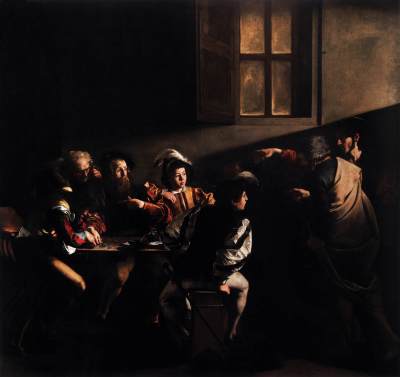
Rather than merely torture visitors to this blog with my own insipid observations about great works of art, I'll also be pointing them to folks much better at writing about these things than I am. One of those is John Berger, in this piece on Caravaggio. Below is his comment on one of my favorite Caravaggios, The Calling of St. Matthew (which Berger would later rewrite a bit for his book Ways of Seeing.
'The Calling of St. Matthew' depicts five men sitting round their usual table, telling stories, gossiping, boasting of what one day they will do, counting money. The room is dimly lit. Suddenly the door is flung open. The two figures who enter are still part of the violent noise and light of the invasion. (Berenson wrote that Christ comes in like a police inspector to make an arrest.)
Two of Matthew's colleagues refuse to look up, the other two younger ones stare at the strangers with a mixture of curiosity and condescension. Why is he proposing something so mad? Who's protecting him, the thin one who does all the talking? And Matthew, the tax-collector with a shifty conscience which has made him more unreasonable than most of his colleagues, points at himself and asks: is it really I who must go? Is it really I?
How many thousands of decisions to leave have resembled Christ's hand here! The hand is hold out towards the one who has to decide, yet it is ungraspable because so fluid. It orders the way, yet offers no direct support. Matthew will get up and follow the thin stranger from the room, down the narrow streets, out of the district. He will write his gospel, he will travel to Ethiopia and the South Caspian and Persia. Probably he will be murdered.
And behind the drama of this moment of decision is a window, giving onto the outside world. In painting, up to then, windows were treated either as sources of light, or as frames framing nature or an exemplary event outside. Not so this window. No light enters. The window is opaque. We see nothing. Mercifully we see nothing because what is outside is threatening. It is a window through which only the worst news can come; distance and solitude.







4 comments:
This site is up on my sidebar with commentary tomorrow.
Cheers.
Thank you, Randall. I'm most appreciative. A reciprocal link to your place will soon be appearing over where the Referer.org links are.
I really enjoyed this Berger essay -- helping me understand not so much Caravaggio -- as why Berger found him so compelling.
But this painting is -- and has been-- effectively -- evangelically? - Christian -- right ? (Our local Jesuit University just presented an elaborate display of Caravaggio reproductions)
If only Caravaggio had been a Marxist ! (but then -- for the thousands of talented Soviet painters in the last century --- I haven't yet seen any of their work come close to Caravaggio's beauty)
Chris,
Thanks for coming by again. For me, it was reading Berger's piece that compelled me to look more closely at Caravaggio.
From what I've read, Caravaggio's art was a tough pill to swallow for at least some of the churches that hired him. Add to that his notorious reputation (openly gay, a brawler, a murderer (a dispute over a game of tennis)) . . . yet it's astounding to me that he was hired at all, much less again and again. The idea of the Jesuits mounting a Caravaggio exhibition seems appropriate, given his and their common beginnings in the Counter-Reformation; just how canonical he's regarded as being isn't something I can speak to, though. I don't see any of those Italian churches rushing to divest themselves of their Caravaggios, though.
You (and others) might enjoy "He Lived Badly, Brutally," an article on Caravaggio--part biography, part "appreciation"--by Jonathan Jones.
Post a Comment